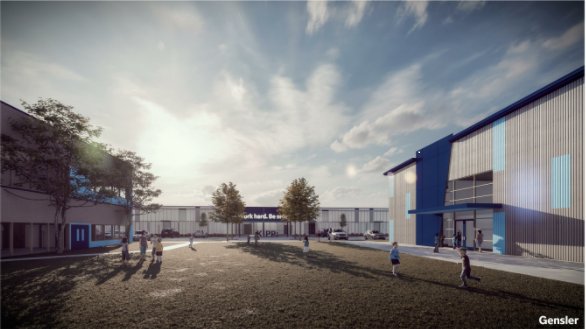Public charter education company KIPP Texas Public Schools is moving ahead with plans to build a new high school in west Houston. The company is in the process of converting a former strip retail center into a 43,490-square-foot school for ninth through 12th graders. The $12.8 million adaptive reuse project at 8450 Westpark Drive will not only add classrooms to the existing structure but also administrative offices and a cafeteria. Records filed with the Texas Department of Licensing and Regulation said the new high school will be called KIPP Sharpstown High School. Construction work on the new high school is scheduled to be completed in time for the fall of 2022.
Construction work on the new high school is scheduled to be completed in time for the fall of 2022.
KIPP is already accepting applications from parents who want to send their children to the school.
Houston-based Anslow Bryant Construction is serving as general contractor for the project, and the Houston office of San Francisco-based Gensler is the architect.
“We were very lucky in that the retail center came on the market three years ago,” said Eric Kot, deputy director of operations at KIPP Texas Public Schools. “It is located right across from our middle school and primary school in the area.”’
The new high school will be about a three-minute walk from the KIPP Sharpstown College Prep middle school at 8440 Westpark Drive and about a six-minute walk from the KIPP Sharp Prep primary school at 8430 Westglen Drive.
“It was really a great coincidence because it fit with our goal of establishing a feeder pattern from pre-K to 12th grade all in the same location,” Kot said. “We’ve been trying to do that with all of our schools, so this was a great opportunity to do that.”
Kot said KIPP takes several different approaches to building the charter schools it runs — everything from ground-up development to the adaptive reuse approach it is taking with KIPP Sharpstown High School to a hybrid approach combining new development with renovating existing buildings. In fact, KIPP Sharpstown High School is also a bit of a hybrid construction job. As part of the project, KIPP plans to enclose an open-air pavilion at KIPP Sharpstown College Prep middle school to create a “gymnatorium” that the high school and middle school will share for sports and large gatherings. The new space will have hardwood floors and a stage,” Kot said.
KIPP already has a large presence in the greater Houston area. The company has dozens of primary and middle schools and six high schools in the area.
In all, the company has some 31,000 students in its schools in Austin, Dallas, Houston and San Antonio.
“Houston is our largest market in Texas,” Kot said. “We have between 16,000 and 18,000 students here in Houston.”
The company recently changed its approach to developing new high schools, Kot said. Rather than build one high school for every two middle schools — Kot called it a two-into-one model — the company is trying to go with a new high school for each of its primary and middle schools, wherever possible.
“We think there is a lot of value in the pre-K and kindergartners being able to look up to the high schoolers,” he said. “It’s also a good for us in recruiting students and helping them all the way through to college.”
In addition to KIPP Sharpstown High School, the company is moving ahead with expansions to some of its other primary and middle schools in Houston.
Construction is underway on the second of a three-phase project at KIPP Mosaic Primary at 12751 Hillcroft Ave., which opened two years ago. The company is also in the final phase of building out KIPP Journey Collegiate School at 14030 Florence Road in Sugar Land, which opened three years ago.
“We’re constantly looking for opportunities to build the next feeder pattern for our students,” Kot said.
As the Houston Business Journal reported last year, with Houston Independent School District struggling with low scores at certain schools, board instability and a lack of quality options in disenfranchised areas, charter schools have emerged as an attractive alternative for many parents. However, some school leaders say charter schools are pulling students — and funding — away from struggling public schools. If school districts are underperforming, businesses may not want to come to Houston, as their employees may not want to enroll their children here.
Educational leaders agree that low rankings and public disapproval of HISD has played a factor in out-of-town businesses not considering Houston, as was witnessed when Amazon passed up establishing its second headquarters in Houston for other more innovative cities.
“If we’re going to compete for Amazon and the like in the future, it’s going to have to be our public schools doing the things necessary to succeed,” Bob Sanborn, CEO of Houston-based Children at Risk, a nonprofit organization that focuses on public policy as it affects the well-being of children, told the Houston Business Journal last year.
Charter schools are independent schools that receive government funding. They are not allowed to charge tuition and are still beholden to federal laws such as Title VI of the Civil Rights Act of 1964, which protects race, color and national origin and Title IX of the Education Amendments of 1972, which protects sex.


